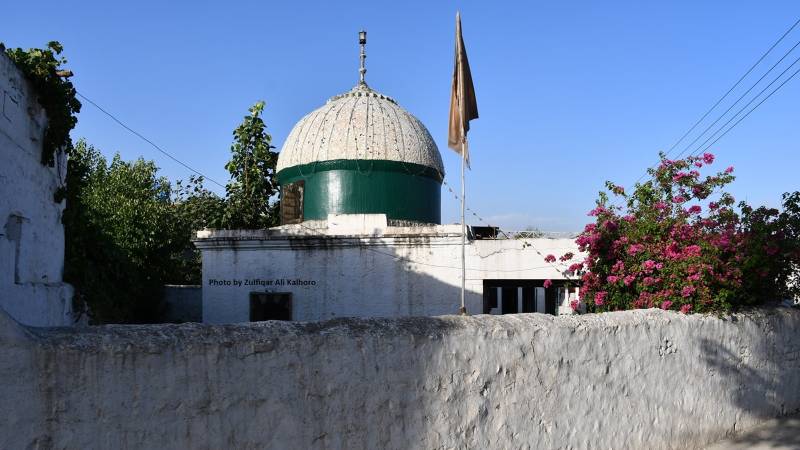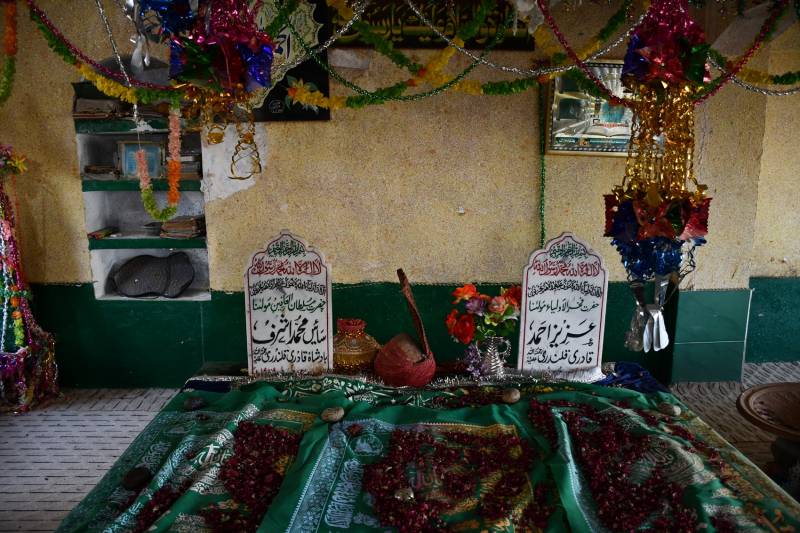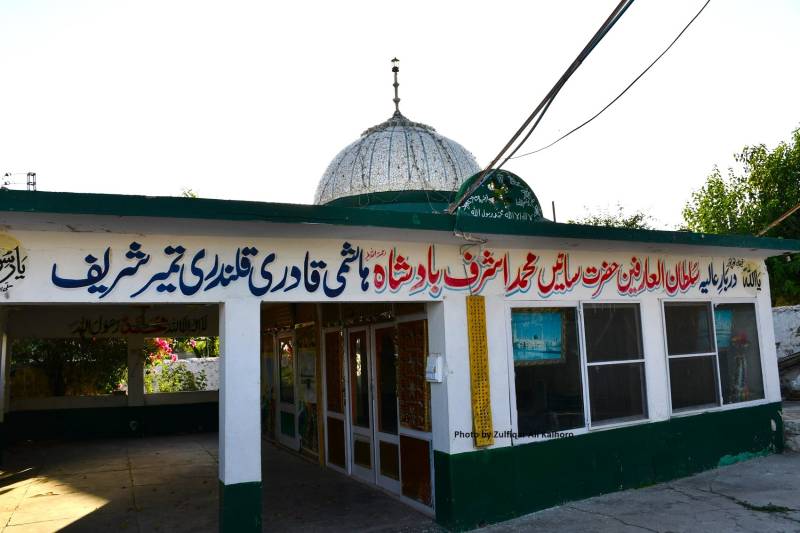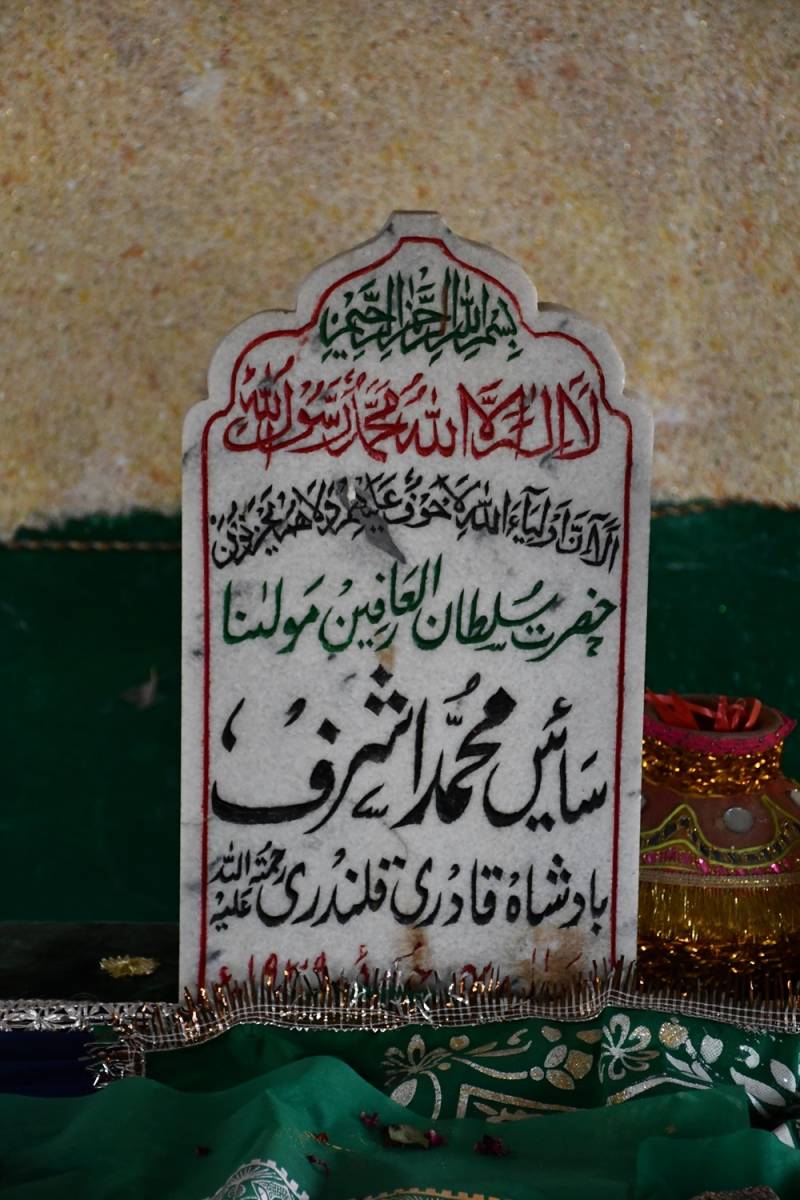
Tumair Sharif village, home to the shrine of Sain Muhammad Ashraf Qadiri Qalandari, holds a profound spiritual connection to Bari Imam (d1705) and Sain Tikka Sarkar (d1930), the spiritual masters of Sain Muhammad Ashraf Qadiri Qalandari (d1939). The shrine is located about 15 km southeast of Bara Kahu via Simly Dam Road and is a testament to the rich spiritual heritage of the Qadiri Qalandari saints of Islamabad.
Tumair Sharif village is a historical village and is a thriving centre of the Qadiriyya-Qalandariyya Silsila. On the way to the shrine of Saint Muhammad Ashraf Qadiri Qalanadri, one first notices the domed structure on the right side of the road that belongs to Baba Sakhi Damat Shaheed (the martyr). There are two graves inside the tomb. One belongs to Baba Damat, popularly known as Sakhi Baba Sarkar. Not much is known about how Baba Sakhi Damat was killed. He was the ancestor of the Danials of Tumair village. About eight or nine old stone graves show the site's antiquity. Three or four stone slabs were used to construct the grave, which is topped by the casket or gravestone. Such stone graves are found in almost every historical village in Islamabad.
Sain Muhammad Ashraf Qadiri Qalandari was known for his piety, and his family was known for its religious education in the area. He was born in 1899 in Tumair village in the house of Qazi Abdullah. Qazi Abdullah had three sons: Qazi Gulzar Ahmed, Qazi Muhammad Akbar Qadiri.
Sain Muhammad Asraf Qadiri Qalandari received early education from his grandfather, Qazi Muhammad Shah, and his father, Qazi Abdullah.
Qazi Muhammad Bakhsh, popularly known as Qazi Muhammad Shah, came from Siham near what is known as today's Haji camp and settled in Tumair. Many eminent scholars migrated from Siham and settled in different villages and towns of Pothohar, and they were known in their respective fields of theology, mysticism, and literature. Apart from Qazi Muhammad Shah Hashmi Qureshi, Mian Abdullah Siham was another person from Siham who was a famous poet and author. Hasan Nawaz Khan of Narali, the author of Gujar Khan ke Suhrawardi Mashaikh (2013), believes that Mian Abdullah Siham was a poet of Persian, Urdu, and Punjabi whose two books Asrar ul-Mohbat (written in 1746) and Gulzar Muhbat (written in 1748) are his two famous literary works.
Qazi Muhammad Shah Hashmi Qureshi was a religious scholar in Tumair village, who established a mosque and started teaching students there. According to Mukhtar Ahmed Qazi, the compiler of Anwar-e-Noorpur, Qazi Muhammad Shah Hashmi Qureshi was spiritually connected to the darbar of Haji Abdullah Shah alias Diwan Huzoori in Bishandaur (now renamed as Diwan-e- Huzoori) in Jhelum’s Sohawa tehsil. Newly born babies in the Qazi Muhammad Shah Hashmi Qureshi family were brought to the Darbar of Haji Abdullah Shah alias Diwan Huzoori. Because of his devotion, he also named his son Abdullah after Haji Abdullah Shah alias Diwan Huzoori.
After completing his education, he chose to serve as a school teacher, guiding the young minds of Narr village in Rawalpindi’s Kahuta with his knowledge and wisdom. He assumed the role of khateeb at the esteemed Jamia Mosque Tumair Sharif. This position commanded great respect and responsibility.
It is said that Sain Muhammad Ashraf Qadiri Qalanadri was particularly inclined towards mysticism. He was searching for a spiritual master and met several mystics to spend time with and learn from them. He also spent some time with one of the eminent Sufi faqirs, Sain Kareem Bakhsh, alias Sain Qemo, who lived in Chirah village in Islamabad. Sain Kareem Bakhsh served in the British army and retired as a soldier. He spent most of his time in prayers. Local people called him Sain or a dervish. Sain Muhammad Ashraf Qadiri Qalandari frequently visited him at Chirah village. Likewise, Sain Kareem Bakhsh also visited Sain Muhammad Ashraf Qadiri Qalandari at Tumair Sharif. The simplicity and way of life of Sain Kareem Bakhsh (d 1939) impressed and influenced Sain Muhammad Ashraf Qadiri Qalandari tremendously. I will write on Sain Kareem Bakhsh separately. Sain Muhammad Ashraf Qadiri Qalandari also led a simple life serving people and shunned himself from a luxurious life.
After meeting many mystics, he finally became a deputy (khalifa) of Sain Tikka Sarkar. Sain Tikka Sarkar initiated Sain Muhammad Ashraf in the Qadiriyya- Qalandariyya Sisila. Tikka Khan was the son of Nadir Khan and belonged to the Satti caste. He was popularly known as Sain Tikka Sarkar. He joined the British army and left after some time. He led a life of a dervish after meeting Nanga Meeran Jatti, a majzub (an ascetic) and a follower of Bari Imam. He was impressed by the spirituality of Nanga/Nangey Shah Meeran Jaatti, whose shrine is located in Islamabad’s Pindori village. One learns from Muhktar Ahmed Qazi’s Anwar-e-Noorpur (2003) that Sain Tikka Sarkar met Nanga Meeran Jatti ( d. 1912) several times. On his instruction, he was initiated into Shah Hussaini Silsila by Sain Inayat Hussain. Shah Hussaini silsila, a sub-branch of Qadiriyya-Qalandariyya, traces their spiritual connection to Bari Imam. Sain Tikka Sarkar passed away in 1930, and as per his will, his funeral prayers were led by his leading khalifa, Sain Muhammad Ashraf Qadiri Qalandari. The shrine of Sain Tikka Sarkar is located at Kamra Sharif in Rawalpindi’s Kotli Sattian.

Sain Muhammad Ashraf Qadiri Qalandari left his job and started spreading the teachings of his spiritual master in his area. Many people responded to his teachings and became his disciples. He frequently visited the shrines of his spiritual masters, Bari Imam (d 1705) and Sain Tikka Sarkar. Sain Muhammad Ashraf Qadiri Qalandari died on July 4, 1939, leaving many disciples to carry his legacy behind. He was buried in Tumair Sharif. His tomb has three graves: Sain Muhammad Ashraf Qadiri Qalandari, his nephew Aziz Ahmed Qadiri Qalandari (d 1987), son of Qazi Gulzar Ahmed (d 1922), and Mukhtar Ahmed. Mukhtar Ahmad was the compiler of Anwar-e-Noorpur. He died in 2004, one year after the publication of his book in 2003.

There are also graves of the family of Sain Muhammad Ashraf Qadiri Qalandari to the west of the tomb. This family graveyard of Sain Muhammad Ashraf Qadiri Qalandari includes the graves of Qazi Muhammad Akbar (d 1960), son of Qazi Abdullah (d 1923), Sahibzada Qazi Fayyaz Ahmed (d 1955), son of Qazi Aziz Ahmed, Qazi Maqbool Ahmed, son of Manzoor Ahmed son of Qazi Aziz Ahmed, Qazi Saeed (d 1950) son of Qazi Muhammad Akbar. To the east of the tomb of Sain Muhammad Ashraf Qadiri Qalandari is the grave of Qazi Manzoor Ahmed.

Qazi Muhammad Akbar, son of Qazi Abdullah, had four sons: Qazi Saeed (d 1950), Qazi Mumtaz, Qazi Muhammad Sharif and Qazi Habibur Rahman. He was a learned scholar and owned a good library that housed rare books and manuscripts on various subjects in Tumair Sharif. He was also khateeb of the Jamia mosque Tumair Sharif.
The grave of Sain Muhammad Ashraf Qadiri Qalandari’s father, Qazi Abdullah, is located in the graveyard of Tumair village’s Ara mohalla or band (the land distribution in the village). According to Sufi Liaquat Hussain, whom I interviewed on the history of mystics of Tumair Sharif, there are four main mohallas: Ara, Havelian, Fatehial, and Jasot. Each of the mohallas is divided further into two to three wards.

